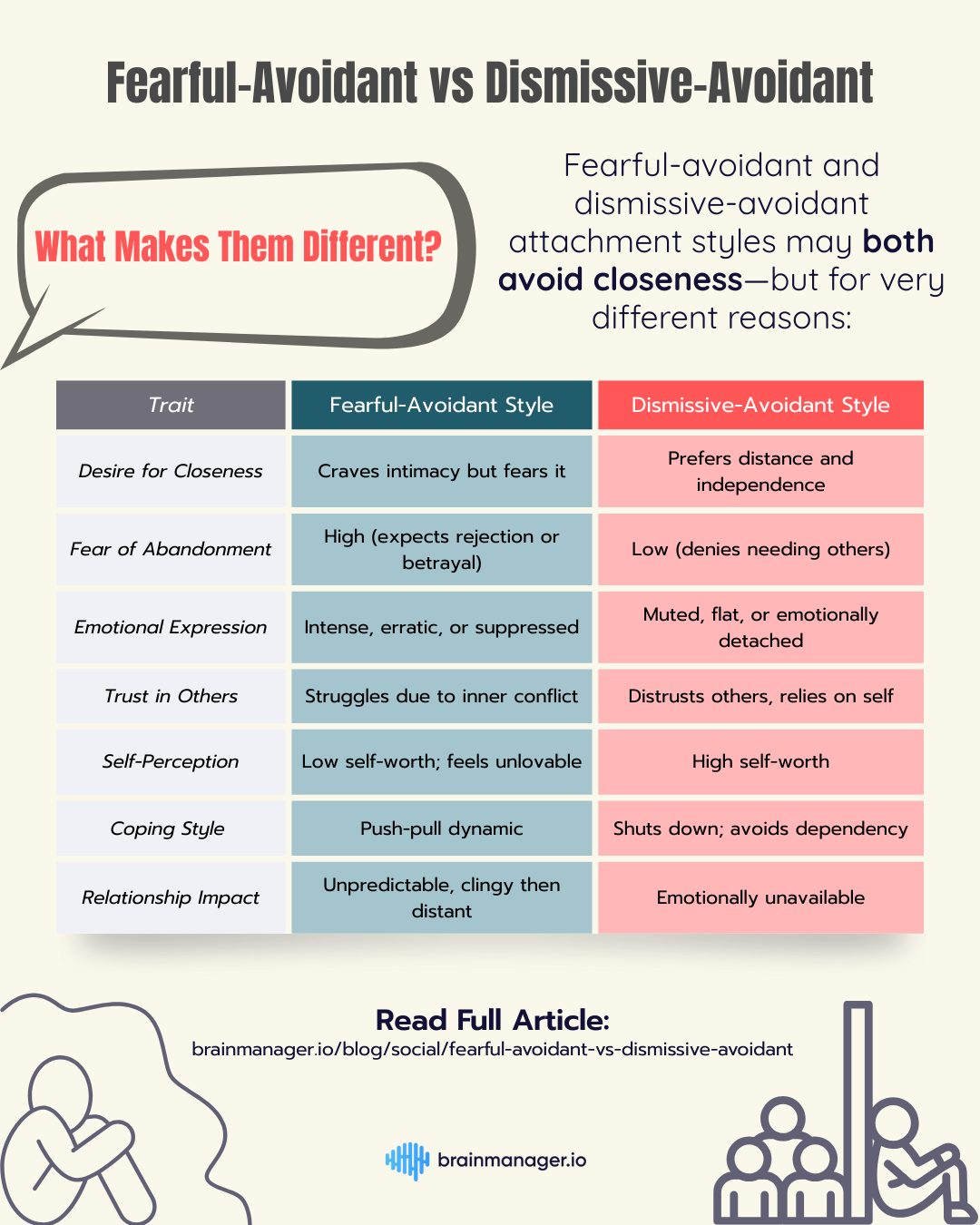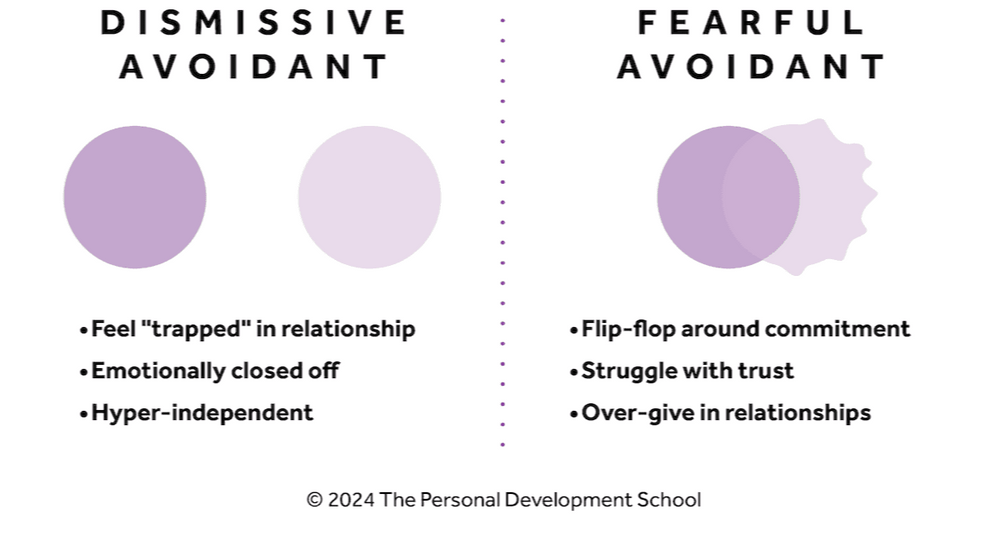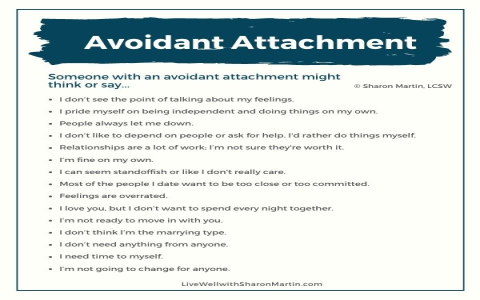Okay, so I’ve been diving deep into this whole attachment style thing lately, trying to make sense of some… interesting… people dynamics I’ve noticed. Specifically, I got tangled up trying to figure out the difference between fearful avoidant and dismissive avoidant. At first, they sounded kinda the same, you know? Both avoidant, right? But man, once I started really observing and thinking it through, the lightbulbs started going off.

My First Stumbles: Getting Them Mixed Up
I started by just reading a bunch of stuff online, trying to get the basics. Everyone’s throwing these terms around. I’d see someone pull away and think, “Ah, avoidant!” But then, the way they pulled away, or what happened before, started to make me scratch my head. Some folks would just ghost, cold as ice, super independent. Others… well, it was more like a push-pull dance, super confusing. That’s when I realized I needed to dig deeper than just the label “avoidant.”
Figuring Out the Dismissive Avoidant: The “I’m Good, Thanks” Crew
So, I started focusing on the ones who just seemed… detached. The dismissive avoidants. What I began to notice was a pattern. These are the people who really, really value their independence, almost to a fault. It’s like they’ve convinced themselves they don’t need deep connections.
I remember this one acquaintance I was trying to get to know better. Every time I’d suggest hanging out or getting a bit more personal, they’d have a super smooth way of deflecting. Not mean, just… unavailable. Always busy, always got something else more important. They’d talk about their achievements, their projects, but very little about feelings or relationships. If relationship stuff came up, they’d often downplay its importance. It was like, “Yeah, feelings are messy, I’m good on my own.” That was a big clue for me. They seemed to genuinely believe they were better off alone, or at least, that relying on others was a weakness.
- Key things I clocked: They often suppress emotions.
- They put a huge emphasis on self-sufficiency.
- They can seem a bit distant or emotionally unavailable.
- They might have a high opinion of themselves and a kinda low-key critical view of others who are “too needy.”
Unpacking the Fearful Avoidant: The Hot and Cold Paradox
Then there was the other type of “avoidant” behavior I was seeing, the fearful avoidant. This one took me longer to get. These folks were a real puzzle. One minute they’d be super into connecting, wanting closeness, sharing vulnerabilities. And then, bam! They’d freak out and push you away. Or they’d get super critical, find reasons why it wouldn’t work out, or just disappear for a bit.
I saw this happen with someone in a group project. They were enthusiastic, full of ideas, really wanted to collaborate. Then, as we got closer to a deadline or if there was any hint of conflict or too much expectation, they’d become really withdrawn, sometimes even a bit passive-aggressive. It was like they desperately wanted to be part of the team and connect, but at the same time, they were terrified of something – maybe getting hurt, or failing, or being rejected. It was this intense internal tug-of-war. They want connection, but they’re scared of it. That was the penny-drop moment for me with fearful avoidants.

- Key things I clocked: A strong desire for closeness, but also a deep fear of it.
- Behavior can be really inconsistent – push-pull, hot-cold.
- They often struggle with trust, both in themselves and others.
- Past hurts often play a big role in their fear.
The Big “Aha!”: How I Finally Told Them Apart in Practice
So, after a lot of observing and some trial-and-error in how I interacted or just understood people, here’s how I started to really differentiate them in my head:
The core desire vs. fear: This became the biggest differentiator for me. Dismissives genuinely seem to devalue or suppress their need for close connection. They build walls to keep people out because they think they don’t need them. Fearfuls, on the other hand, crave connection, but their fear of intimacy and potential pain is so strong it sabotages them. They build walls, then frantically try to peek over them or tear them down, only to rebuild them again.
Their view of self and others: Dismissives often have this air of “I’m good, you’re maybe a bit flawed/needy.” They might see themselves as strong and independent, and others as less capable. Fearfuls often have a more negative view of both themselves (“I’m not worthy of love”) and others (“People will eventually hurt me”). It’s a double whammy.
Consistency of behavior: Dismissives are often consistently distant. Their avoidance is more of a steady state. Fearfuls are like a rollercoaster. You never quite know if you’re going to get the “come closer” version or the “go away” version.
It was like, the dismissive person decided early on, “Relationships? Nah, not for me. Too much trouble.” And they stick to it. The fearful person is like, “I want a relationship so badly! Oh god, this is terrifying, run away! Wait, no, come back, I’m lonely!”

Understanding this distinction hasn’t made me a mind-reader, obviously. But it’s definitely helped me make more sense of some confusing interactions and be a bit more patient. It’s a work in progress, this whole understanding people thing, but every little bit helps, right?











